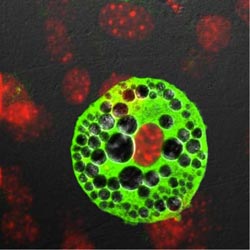Newly-discovered human fat cell opens up new opportunities for future treatment of obesity

Researchers at Sahlgrenska Academy, University of Gothenburg, Sweden, have discovered that we humans have two different kinds of brown fat cells and not one kind as previously thought.<br>
Researchers at Sahlgrenska Academy, University of Gothenburg, Sweden, have now discovered that we humans have two different kinds of brown fat cells and not one kind as previously thought. This discovery, now published in Nature Medicine, opens up new opportunities for future medicines that exploit the brown fat cells' ability to consume calories.
Unlike white fat cells, which store the body's surplus energy in the form of fat, brown fat cells have the unique property of being able to burn energy and turn it into heat.
The study now published by the researchers at the University of Gothenburg shows for the first time that people have at least two different kinds of brown fat cells – not just one as was previously thought. According to Sven Enerbäck, who heads the country's leading research group in the study of fat cells and metabolism, this is an interesting discovery.
“We already know that those of us who have more brown fat tissue have a smaller risk of developing type 2 diabetes. With these new results, we should eventually be able to develop methods for stimulating the brown fat tissue, so that some of the surplus energy we store in the form of fat tissue can be converted into heat. Such a treatment could both prevent obesity and reduce the risk of developing obesity-related diseases such as type 2 diabetes,” says Sven Enerbäck.
The researchers call the new type of brown fat tissue that they have discovered “classical brown fat”. According to the Gothenburg study, young people have this classic brown fat tissue, but it seems to disappear during adolescence.
“One idea is to be able to “reactivate” the classical brown fat tissue in older people and so treat obesity,” says Sven Enerbäck.
The research into brown fat tissue is being done in close cooperation with researchers at Linköping University.
The article “Evidence for two types of brown adipose tissue in humans” is published online in Nature Medicine on April 21.
Link to article: http://www.nature.com/nm/journal/vaop/ncurrent/full/nm.3017.html
Contact:
Sven Enerbäck, Professor, Sahlgrenska Academy, University of Gothenburg
Mobile: 070-629 49 46
Telephone: 031-786 3334
Media Contact
All latest news from the category: Health and Medicine
This subject area encompasses research and studies in the field of human medicine.
Among the wide-ranging list of topics covered here are anesthesiology, anatomy, surgery, human genetics, hygiene and environmental medicine, internal medicine, neurology, pharmacology, physiology, urology and dental medicine.
Newest articles

Bringing bio-inspired robots to life
Nebraska researcher Eric Markvicka gets NSF CAREER Award to pursue manufacture of novel materials for soft robotics and stretchable electronics. Engineers are increasingly eager to develop robots that mimic the…

Bella moths use poison to attract mates
Scientists are closer to finding out how. Pyrrolizidine alkaloids are as bitter and toxic as they are hard to pronounce. They’re produced by several different types of plants and are…

AI tool creates ‘synthetic’ images of cells
…for enhanced microscopy analysis. Observing individual cells through microscopes can reveal a range of important cell biological phenomena that frequently play a role in human diseases, but the process of…





















